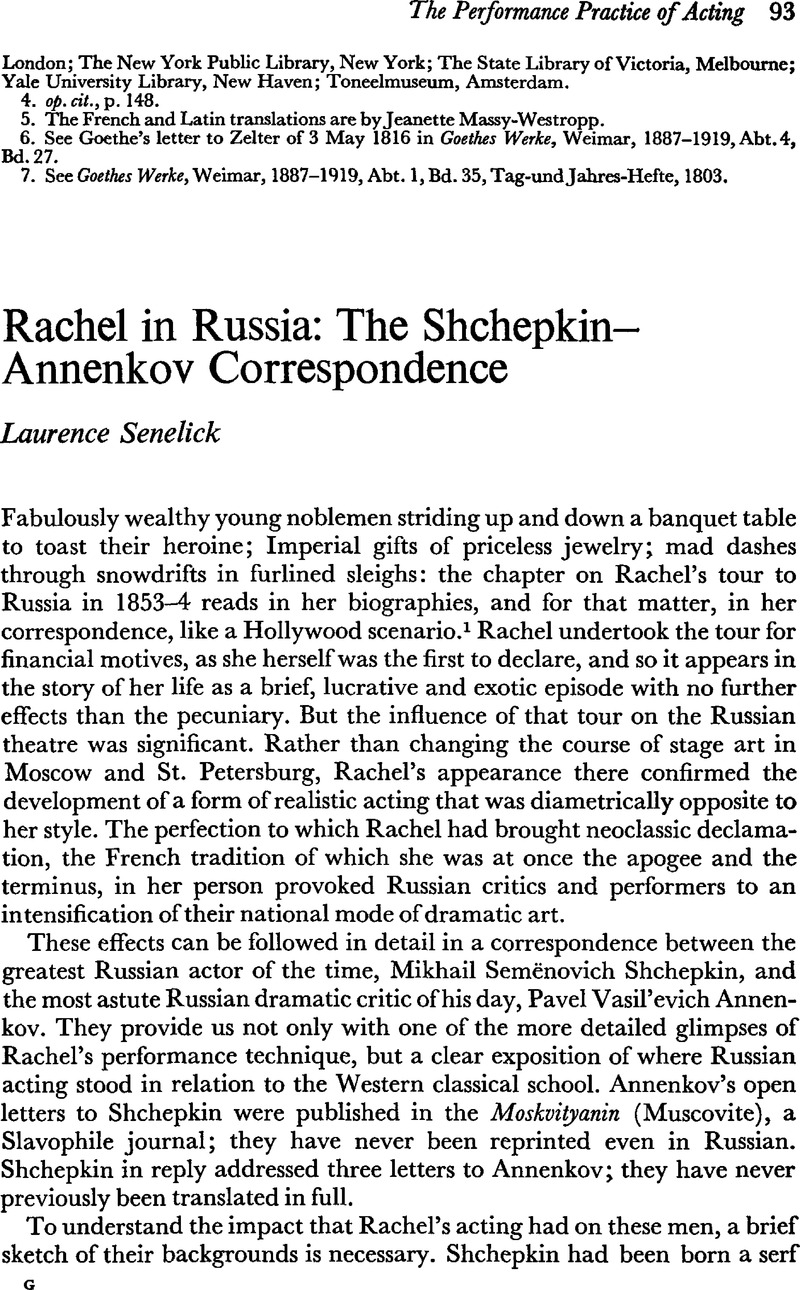No CrossRef data available.
Article contents
Rachel in Russia: The Shchepkin–Annenkov Correspondence
Published online by Cambridge University Press: 23 January 2009
Abstract

- Type
- Articles
- Information
- Copyright
- Copyright © International Federation for Theatre Research 1978
References
Notes
1. See, for instance, de Barrera, Madame, Mémoires de Rachel (London: Hurst & Blackett, 1858) pp. 147–50Google Scholar; and d'Heylé, Georges, Rachel d'après sa correspondence (Paris: Librairie des bibliophiles, 1882), p. 195Google Scholar. Leont'evskiy, N., ‘Russkie gastroli Elizy Rashel’, Ezhegodnik instituta istorii iskusstv (Moskva, 1959) pp. 267–75Google Scholar, gives a modern, unromantic picture.
2. Sovremennik (1849) XV, 5–6, p. 83.Google Scholar
3. Kublitskiy, M. E., ‘Ocherki evropeyskikh teatrov’, Pisem i zamechaniy puteshestvennika (Moskva, 1848) p. 145.Google Scholar
4. Shchepkin, M. S., Mikhail Semënovich Shchepkin 1788–1863. Zapiski ego, pis'ma, rasskazy, materialy dlya biografii i rodoslovnaya, ed. Shchepkin, M. A. (St Petersburg, 1914) p. 270.Google Scholar
5. Moskvityanin (1853) XX, viii, p. 180.Google Scholar
6. Shchepkin, M. S., Zapiski, pis'ma. Sovremenniki o M.S.Shchepkine, ed. Klinchin, A. P. (Moskva: Iskusstvo, 1952) pp. 263–4.Google Scholar
7. Ezhegodnik imperatorskikh teatrov (1894–1895) II, 3.Google Scholar
8. Shubert, A. I., Moya zhizn', ed. Derman, A.. (Leningrad: Academia, 1929), p. 160.Google Scholar
9. Annenkov, P. V., ‘Pis'mo iz Peterburga o Rashele (k M. S. Shchepkinu)’, Moskvityanin (1853) XXII, vii, 86.Google Scholar
10. ibid.
11. ibid.
12. ibid., 87.
13. ibid., 87–88.
14. ibid., p.89.
15. ibid., p.90.
16. ibid.
17. ibid., p. 90–1.
18. ibid., p.91–2.
19. ibid., p. 92.
20. ibid., p. 92–3.
21. Shchepkin, M. S., Zapiski, pp. 233–4.Google Scholar
22. Annenkov, P. V., ‘Vtoroe pis'mo o Rashele k M. S. Shchepkinu’, (1853) XXIII, vii, 132.Google Scholar
23. ibid., pp. 132–3.
24. ibid., p. 135.
25. ibid., p. 137.
26. ibid.
27. ibid., p. 139. Annenkov's opinion was seconded by the poet and dramatist A. K. Tolstoy in a letter to his friend S. A. Miller: ‘By and large I find Rachel insufferable [as Adrienne Lecouvreur] and her acting false and affected; what's more, she's surrounded by a pack of scoundrels who play even worse than she … Fabricated effects, vocal modulations, now dying, now shrieking, always preconceived, always false intonations, intended to summon applause, and which, to my mind, summon it just as a favor – it all wearied me and got on my nerves'. (Tolstoy, A. K., 15 11 1853, in Sobranie sochineniy v chetyrakh tomax [Moskva: ‘Pravda’, 1969] IV, 277).Google Scholar
28. Annenkov, , ‘Utoroe pis'mo…’Google Scholar
29. Shchepkin, , Zapiski, pp. 234–5.Google Scholar
30. Annenkov, , ‘Rashel' v Peterburg. (3–e pis'mo k M. S. Shchepkinu)’, Moskvityanin (1854) III–IV, vii, 103.Google Scholar
31. ibid., p. 105.
32. ibid., p. 106.
33. ibid., p. 108.
34. ibid.
35. ibid., p. 110.
36. ibid., pp. 111–12.
37. ibid., p. 112.
38. Vedomosti moskovskoy gorodskoy politsii, 27 02 1854Google Scholar. Quoted in Grits, T. S., M. S. Shchepkin: letopis' zhizni i tvorchestva (Moskva, Nauka, 1966) p. 531.Google Scholar
39. Berg, N. V. in Russkaya Starina (1884) X, 71.Google Scholar
40. Quoted in Grits, , op.cit., pp. 530–31.Google Scholar
41. ibid.
42. ‘Dva slova o Rasheli v Moskva’, Moskvityanin, (1854) III–IV, vii, 165–6.Google Scholar
43. ibid.
44. Aksakov, S. T., Sobranie sochineniy v chetyrakh tomakh (Moskva, 1956) III, 400.Google Scholar
45. Shchepkin, from childhood, had been prone to great rapidity of speech on stage, often to the point of incomprehensibility, and had striven to overcome this defect. Still, he found it preferable to protracted mouthing of speeches.
46. Shchepkin, , Zapiski, pp. 235–7Google Scholar. Shchepkin's thumbnail sketch of the rise and fall of declalamation in Russia may not be wholly accurate. According to the diarist S. P. Zhikharev, the first person to croon in Russian tragedy was Pushkin's favorite tragedienne Ekaterina Semenova: ‘prior to her, although verse was not recited on stage like prose but with some attention to metre, still it was not at all sung’. Semënova misunderstood George's style and diction, and proceeded to draw out the couplets and prolong words much to the disapprobation of older experienced actors who refused to compound the error, even in the face of Semënova's success with her singsong declamation. Similarly, her tutor Gnedich, who had never travelled and had therefore never encountered European stage celebrities, was bowled over by George, the first talented actress he had seen, and sought to model Semënova on her. He was a translator of Homer, and his ear, attuned to Greek hexameters, found in George's rhythms the key to the mystery of dramatic declamation. ‘Unfortunately, this diction, never before heard on the Russian stage, found its adherents, pleased the public, and Semënova was declared the greatest actress on earth’. (Zhikharev, S. P., Zapiski sovrewemennika, Moskva–Leningrad: Academia, 1934, II, 371, 374).Google Scholar
47. The Letters of David Garrick, ed. Little, D. M. and Kahrl, G. M.. (Cambridge, Mass; Harvard U. press, 1963) II, 635.Google Scholar
48. Talma, F. J., Reflections on the Actor's Art (1825). (New York: Dramatic Museum of Columbia University, 1915) p. 25.Google Scholar
49. Panteon (1854) IV, 4–5.Google Scholar
50. Quoted in Grits, , op. cit., p. 535.Google Scholar
51. Afanas'ev, A. N., ‘M. S. Shehepkin i ego zapiski’, Biblioteka dlya chteniya (02 1864) p. 3.Google Scholar
52. ibid.
53. Chekhov, A. P., ‘Opyat' o Sare Bernar’, Polnoe sobranie sochineniy i pisem (Moskva, 1944) I, 486.Google Scholar




